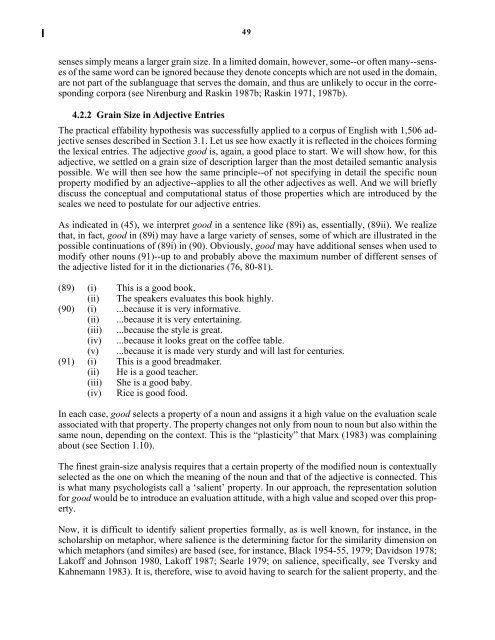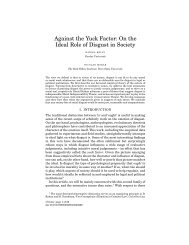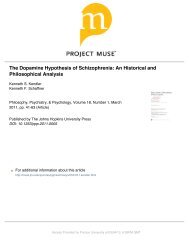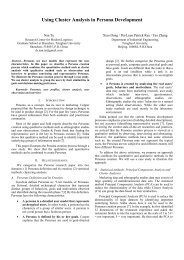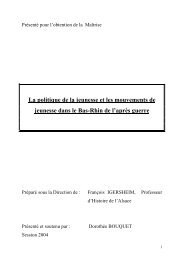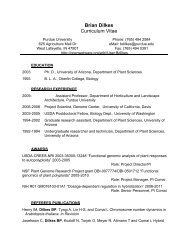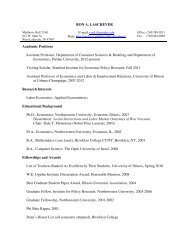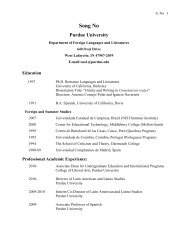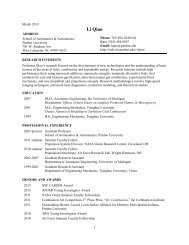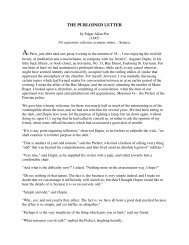Lexical Semantics of Adjectives - CiteSeerX
Lexical Semantics of Adjectives - CiteSeerX
Lexical Semantics of Adjectives - CiteSeerX
You also want an ePaper? Increase the reach of your titles
YUMPU automatically turns print PDFs into web optimized ePapers that Google loves.
49<br />
senses simply means a larger grain size. In a limited domain, however, some--or <strong>of</strong>ten many--senses<br />
<strong>of</strong> the same word can be ignored because they denote concepts which are not used in the domain,<br />
are not part <strong>of</strong> the sublanguage that serves the domain, and thus are unlikely to occur in the corresponding<br />
corpora (see Nirenburg and Raskin 1987b; Raskin 1971, 1987b).<br />
4.2.2 Grain Size in Adjective Entries<br />
The practical effability hypothesis was successfully applied to a corpus <strong>of</strong> English with 1,506 adjective<br />
senses described in Section 3.1. Let us see how exactly it is reflected in the choices forming<br />
the lexical entries. The adjective good is, again, a good place to start. We will show how, for this<br />
adjective, we settled on a grain size <strong>of</strong> description larger than the most detailed semantic analysis<br />
possible. We will then see how the same principle--<strong>of</strong> not specifying in detail the specific noun<br />
property modified by an adjective--applies to all the other adjectives as well. And we will briefly<br />
discuss the conceptual and computational status <strong>of</strong> those properties which are introduced by the<br />
scales we need to postulate for our adjective entries.<br />
As indicated in (45), we interpret good in a sentence like (89i) as, essentially, (89ii). We realize<br />
that, in fact, good in (89i) may have a large variety <strong>of</strong> senses, some <strong>of</strong> which are illustrated in the<br />
possible continuations <strong>of</strong> (89i) in (90). Obviously, good may have additional senses when used to<br />
modify other nouns (91)--up to and probably above the maximum number <strong>of</strong> different senses <strong>of</strong><br />
the adjective listed for it in the dictionaries (76, 80-81).<br />
(89) (i) This is a good book.<br />
(ii) The speakers evaluates this book highly.<br />
(90) (i) ...because it is very informative.<br />
(ii) ...because it is very entertaining.<br />
(iii) ...because the style is great.<br />
(iv) ...because it looks great on the c<strong>of</strong>fee table.<br />
(v) ...because it is made very sturdy and will last for centuries.<br />
(91) (i) This is a good breadmaker.<br />
(ii) He is a good teacher.<br />
(iii) She is a good baby.<br />
(iv) Rice is good food.<br />
In each case, good selects a property <strong>of</strong> a noun and assigns it a high value on the evaluation scale<br />
associated with that property. The property changes not only from noun to noun but also within the<br />
same noun, depending on the context. This is the “plasticity” that Marx (1983) was complaining<br />
about (see Section 1.10).<br />
The finest grain-size analysis requires that a certain property <strong>of</strong> the modified noun is contextually<br />
selected as the one on which the meaning <strong>of</strong> the noun and that <strong>of</strong> the adjective is connected. This<br />
is what many psychologists call a ‘salient’ property. In our approach, the representation solution<br />
for good would be to introduce an evaluation attitude, with a high value and scoped over this property.<br />
Now, it is difficult to identify salient properties formally, as is well known, for instance, in the<br />
scholarship on metaphor, where salience is the determining factor for the similarity dimension on<br />
which metaphors (and similes) are based (see, for instance, Black 1954-55, 1979; Davidson 1978;<br />
Lak<strong>of</strong>f and Johnson 1980, Lak<strong>of</strong>f 1987; Searle 1979; on salience, specifically, see Tversky and<br />
Kahnemann 1983). It is, therefore, wise to avoid having to search for the salient property, and the


